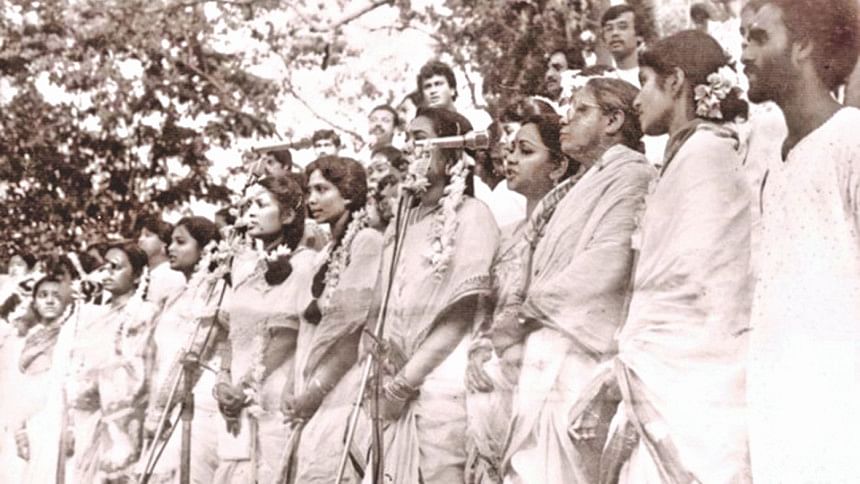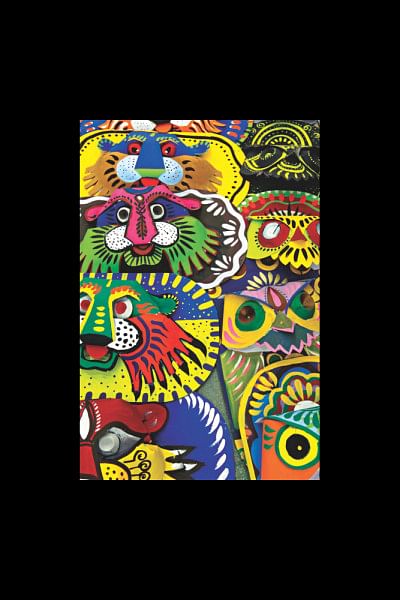Emergence of Bengali New Year and Calender

As an old saying goes: "Bengalis have thirteen festivals in twelve months." This experience-based adage gives an impression of a society which was affluent, cohesive and joyful. It further reveals that the society of olden Bengal had been featured by an intense cultural atmosphere and resulting social euphoria.
The above saying actually holds true about Hindu Bengalis. So far as culture is concerned, Bengali Muslim life in Bengal had differed substantially from that of their Hindu neighbours. Bengali Muslims, had, in fact, no ethnic, indigenous or locally originated (except for a few legends, or cult-based quasi-religious events) national, regional or group-centred secular cultural festivals. All their broad-based, community-oriented and family-centred festivals were religious or semi-religious in nature. As for example, two Eid festivals and celebration of tragic Karbala episode of Islamic history (Muharram) had been narrated by Morshia singers and Jari narrative performers. Another important feature of Karbala episode had also been performed by Puthials (Performers those who narrate the Karbala episode in a very stylistic manner and impressive tune and rhythmic voice). This is how the Muslims of Bengal had created a culture-basis for their artistic expressions. It is important to note that the Bengali Hindus had also a cultural setting of Puthi literature. Their Puthis centred round Hindu mythologies and portions of grand narratives of Ramayana and Mahabharat. The two thematic patterns of Bangla Puthi literature came closer to each other through the interaction of Hindu and Muslim Puthi researchers. It was perhaps the meeting point of cultural interaction of two communities. And slowly but definitely the same geographical setting and the socio-economic milieu of their habitat and religious beliefs produced an eclectic mindset. This is how a very significant metamorphosis occurred in Bengali society over the years. In this process, a synthetic and pluralistic cultural worldview developed in Bengali society. This development had been rightly termed by renowned political scientist and cultural analyst Badruddin Umar as the “Bengali Muslims' home-coming”.

The language movement of 1952, had in fact, played a decisive role in shaping and sharpening the Bengali identity of the emerging generations of forwarding looking Bengali Muslims. Besides, the shared tradition of Bengali Language and Literature had always been a perennial source of strengthening Bengali identity.
This new generation of Bengali nationalist Muslims was searching for some lively and solid component of their newly found secular nationalism. Bengali Era and the age-old tradition of Pahela Baishakh (first day of Bengali almanac's first month) celebrations in rural Bengal provided them with a strong basis for their new pursuit of cultural synthesis based on tolerance, pluralistic attitude and humanism. Bengali Era and its primordial celebrations helped them remodel and augment their new cultural aptitude.
Bangla San (calendar), recently used as Bangabdha by the elites is essentially a hybrid era. For this reason it is a common heritage of almost all sections of people of Bengal. Highly acclaimed scientist and Indian almanac reformer Dr Meghnad Saha, while identifying the genesis of Bengali Era said "After the introduction of Tarik-i-Ilahi (1556 AD) in the year of his accession to the throne by Emperor Akbar, the people of Bengal began to use the Surya Sidhanta reckoning and the solar year. For calculating the Bangla San, we take Hijri year, elapsed in 1556 i.e. 963 and add to it the number of solar years." If we follow this rule the reckoning of the Bengali new year today would be 963+2014 AD-1556=1421 Bangla San.
Dr Saha believed that the Bangla San derived from Tarik-i-Ilahi (1556 AD) of Emperor Akbar. And, it is an amalgam of Lunar year, Hijri and Indian solar year. Akbar's court astronomer Fatehullah Shirajee introduced this hybrid reckoning system. Bengali Nobel laureate Professor Amartya Sen's comment in this regard is amusing. He wrote, "When a Bengali Hindu does his religious ceremonies according to the local calendar, he may not be fully aware that the dates invoked in his Hindu practice is attuned to commemorating Mohammad's flight from Mecca to Madina, albeit in a mixed lunar -- solar representation (An Assessment of the Millennium -- address, 20th August 1998 -- New Delhi). In one of my earlier interviews in the Daily Star I expressed a different genesis of Bengali New Year and its calendar. I said, “The history of Bengali New Year and calendar is somehow unclear and it is difficult to say exactly when it came about, but some assumptions can be made based on circumstantial evidence. The fact that, it is called Bangla San or Sal, which are Arabic and Persian words respectively, suggests that it was introduced by a Muslim Kings or Sultans. Some historians suggest Mughal Emperor Akbar, as he had reformed the Indian calendar - with the help of his astronomer Fatehullah Shirajee - in line with the Iranian Nowroj or new day. Others suggest it was the seventh century king Sasanka.
I personally believe it was Nawab Murshid Kuli Khan who was earlier a Subedar or Mughal Governor and later a Nawab, who celebrated Bengali traditions such as the Punyaha, a day for ceremonial land-tax collection. I believe he used Akbar's New Year framework, revenue reforms and fiscal policy and started the Bangla Calendar.”
However, Bangla San is a manifestation of engaging cultural integration. In fact, the Bengali culture is a mixed culture and it encompasses the elements of many civilizations, races and religions.
The deltaic civilization of Bengal is based on agricultural economy. Agrarian milieu produces many rituals and indigenous practices, rituals - even the primordial ones, are abundantly found in rural Bengal. Some of the surviving rituals and local cults had nicely been integrated with the later modern construction, namely the present day Bangla Navabarsa Utsab (Bengali New Year's festival). These primordial agriculture-related rituals include, 'Amani' and many other minor local practices. 'Amani' is a domestic ritual performed on the first day of the Bengali New Year's morning by individual agricultural families for the well-being of the family members and good harvest throughout the year.
Gamvira is also a local cultural event found mainly in Maldah and Chapai Nawabgonj districts of India and Bangladesh respectively. It is composed of dramatic movements, and social problem-oriented dialogue between the two main performers and along with folk song and dance. Outwardly, a humorous folk art form Gamvira is an event of contemporary social criticism. This folkloric genre has thrived in new born Bangladesh state. A regional folk performance of Chapai Nawabgonj and adjacent areas is now performed in different parts of Bangladesh. It is also a very favorite event of television shows and radio broadcasts.
Another local event of Baishakh is Bali Khela. It is a wrestlers' game. This Baishakhhi festival-game was introduced by Abdul Jabbar, a champion Bali of Chittagong during the early years of last century. Jabbar's Bali Khela is still very popular and held every year at Laldighi Maidan, Chittagong on 12th Baishakh.
Another regional event of Baishakh was Cattle Race. Munshiganj and Manikgonj were famous for this colourful fiesta. Netrakona and Brahmanbaria were well-known for bull fight and cock fight respectively.
Some of these regional events are now extinct or on the verge of extinction.
Let us now look at the bigger Baishakhi festive occasions. These are Punyaha, Halkhata and Mela. Punyaha denotes 'a sacred day'. The zamindars of Bengal observed this day during the month of Baishakh to collect land-tax from their subjects. There were much pomp and grandeur at the zaminder's palace or Kachari (land-tax collection office). On this occasion zamindars gave audience to their subjects, exchanged greetings and entertained them with sweets, betel nuts etc. Once a universal Baishakhi festival, Punyaha is now extinct with the abolition of zamindary system.
It now exists only in Chittagong Hill Tracts. Tribal kings observe this occasion with much festivity and fanfare.
Halkhata was also a nation-wide celebration of Pahela Baishakh. Dr Muhammad Enamul Huq rightly observed that Halkhata is the opposite side of the coin, named Punyaha. Business communities of the country up to the level of village grocers arranged Halkhata event almost compulsorily. It was, in fact, a requisite for business in Bangladesh. Our economy was totally agriculture-oriented, where cash sale was almost impossible because 80 percent of the population were village-dwellers and dependent on agriculture. For this reason they did not have channels of regular flow of cash money. They did grow jute and paddy and sell them to acquire cash money. With this seasonal cash money they bought their yearly clothes and other necessary items for the whole family. So purchasing daily necessities on credit was inevitable. That is why the Halkhata was so important. Halkhata is a suitable occasion for the consumers to clear their debts. It gives them pleasure, satisfaction and some sort of pride in the society. Business houses entertain their customers and patrons with sweets. They also decorate their shops with festoons and flowers.
After the independence of Bangladesh, our economy has grown more or less on a capitalist path and a large number of cash money-holding consumers have emerged. This situation reduces the importance of Halkhata.
From earliest times, the Mela (fair) was a main component of Baishakhi observances. This component has now thrived qualitatively. It is believed that nearly three hundred fifty Melas are now organised in Bangladesh during the month of Baishakh. Baishakhi Mela organised by the Bangladesh Small and Cottage Industries Corporation (BSCIC) and Bangla Academy is spatially massive and temporally lengthy.
Bengali New Year celebrations have played a politically significant and culturally decisive role in Bangladesh. During the semi-colonial and cultural repressive Pakistani period, East Bengalis faced a stiff resistance in organising the Bengali New Year's day. In the face of this negative stance by the then central government, Bengali scholars and cultural activists put forward the argument that Bengali Era was introduced by Emperor Akbar and it was originally been taken from Iranian new year's festival Nowruz. So its Muslim origin is unquestionable. Pakistani rulers, particularly the military regime of Ayub Khan, did not pay any heed to these arguments. On the contrary, the autocratic regime imposed ban on Rabindra Sangeet (Tagore song) in 1967. This culturally repressive role of the then central Pakistani government infuriated the Bengalees. And it added a political dimension to cultural emancipation. During this year (1967) Chayanaut, a leading cultural organisation of the country, organised the Pahela Baishakh celebration at Ramna green. It was meticulously organised, neatly produced and attended by a modest-sized middle class audience. But this innovative performance helped enkindle a new spirit among the growing Bengali middle class. In fact, this initiative had sharpened the Bengali identity and added fuel to the growing Bengali nationalism.
After the emergence of Bangladesh, Chayanaut's Bengali New Year celebrations at Ramna Batamul have become phenomenal. These have been massive and ever increasing. It is in fact, a great historic festival and the only secular cultural festival of the country where all communities of the Bengali population participate. It is interesting to note that Bengali New Year's Day celebrations of olden times were rather small, localised and group-based folk events and observed only in idyllic rural surroundings. Now this tradition has changed. The present-day urban revival of the New Year's celebration is a case in point. The old rituals and local cultural symbolic components have had a rebirth and added a multi-dimensional significance. Its role of protests against religious fundamentalism and autocratic regimes is manifested significantly. The unique Nababarsha parade and its masks are a critique on social injustices and other ills of society. So, it has now been playing a very important role in shaping modern secular and cohesive Bengali society with its live connection with our roots.
The writer is Director General, Bangla Academy.
The article was originally printed in Daily Star's 2014 Nabababarsha Special Supplement

 For all latest news, follow The Daily Star's Google News channel.
For all latest news, follow The Daily Star's Google News channel. 



Comments